child restraint BMW X5 4.6IS 2003 Owners Manual
[x] Cancel search | Manufacturer: BMW, Model Year: 2003, Model line: X5 4.6IS, Model: BMW X5 4.6IS 2003Pages: 183, PDF Size: 2.31 MB
Page 44 of 183
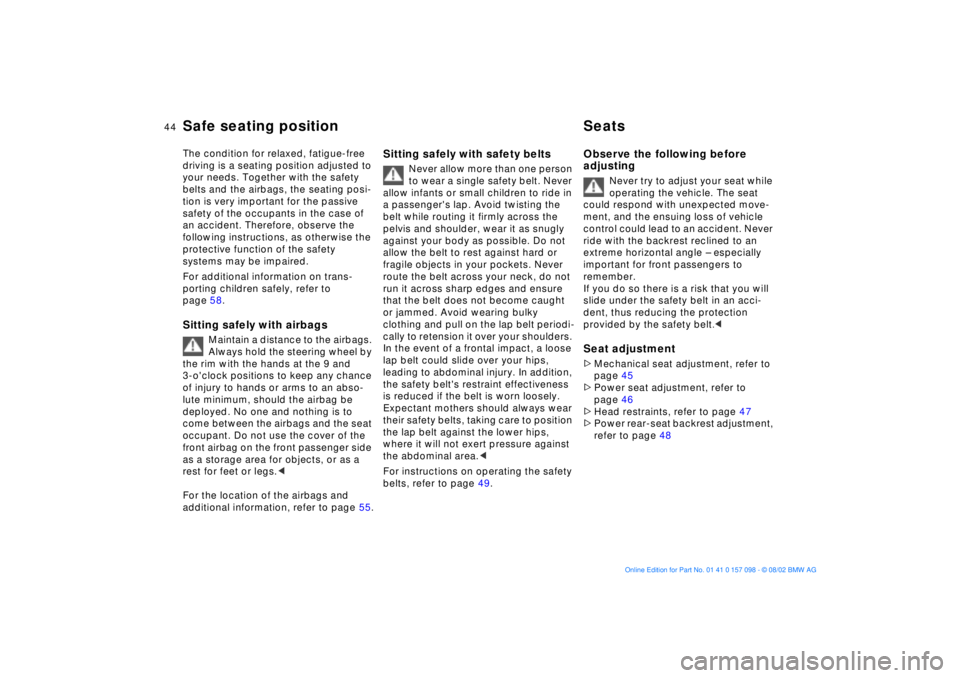
44n
The condition for relaxed, fatigue-free
driving is a seating position adjusted to
your needs. Together with the safety
belts and the airbags, the seating posi-
tion is very important for the passive
safety of the occupants in the case of
an accident. Therefore, observe the
following instructions, as otherwise the
protective function of the safety
systems may be impaired.
For additional information on trans-
porting children safely, refer to
page 58.
Sitting safely with airbags
Maintain a distance to the airbags.
Always hold the steering wheel by
the rim with the hands at the 9 and
3-o'clock positions to keep any chance
of injury to hands or arms to an abso-
lute minimum, should the airbag be
deployed. No one and nothing is to
come between the airbags and the seat
occupant. Do not use the cover of the
front airbag on the front passenger side
as a storage area for objects, or as a
rest for feet or legs.<
For the location of the airbags and
additional information, refer to page 55.
Sitting safely with safety belts
Never allow more than one person
to wear a single safety belt. Never
allow infants or small children to ride in
a passenger's lap. Avoid twisting the
belt while routing it firmly across the
pelvis and shoulder, wear it as snugly
against your body as possible. Do not
allow the belt to rest against hard or
fragile objects in your pockets. Never
route the belt across your neck, do not
run it across sharp edges and ensure
that the belt does not become caught
or jammed. Avoid wearing bulky
clothing and pull on the lap belt periodi-
cally to retension it over your shoulders.
In the event of a frontal impact, a loose
lap belt could slide over your hips,
leading to abdominal injury. In addition,
the safety belt's restraint effectiveness
is reduced if the belt is worn loosely.
Expectant mothers should always wear
their safety belts, taking care to position
the lap belt against the lower hips,
where it will not exert pressure against
the abdominal area.<
For instructions on operating the safety
belts, refer to page 49.
Observe the following before
adjusting
Never try to adjust your seat while
operating the vehicle. The seat
could respond with unexpected move-
ment, and the ensuing loss of vehicle
control could lead to an accident. Never
ride with the backrest reclined to an
extreme horizontal angle Ð especially
important for front passengers to
remember.
If you do so there is a risk that you will
slide under the safety belt in an acci-
dent, thus reducing the protection
provided by the safety belt
.<
Seat adjustment>Mechanical seat adjustment, refer to
page 45
>Power seat adjustment, refer to
page 46
>Head restraints, refer to page 47
>Power rear-seat backrest adjustment,
refer to page 48
Safe seating position Seats
Page 56 of 183
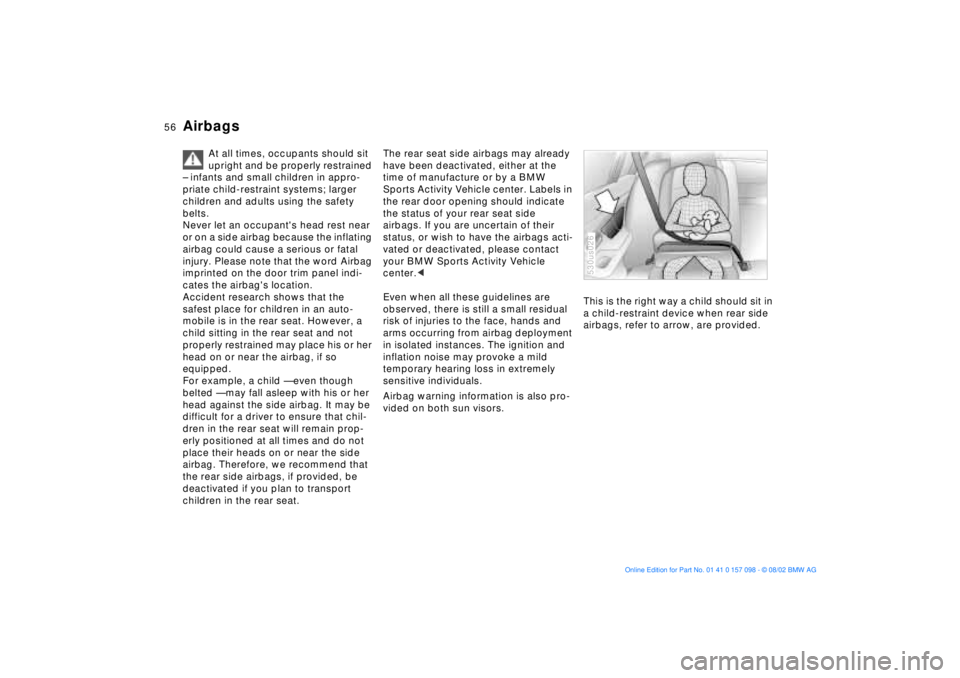
56n
Airbags
At all times, occupants should sit
upright and be properly restrained
Ð infants and small children in appro-
priate child-restraint systems; larger
children and adults using the safety
belts.
Never let an occupant's head rest near
or on a side airbag because the inflating
airbag could cause a serious or fatal
injury. Please note that the word Airbag
imprinted on the door trim panel indi-
cates the airbag's location.
Accident research shows that the
safest place for children in an auto-
mobile is in the rear seat. However, a
child sitting in the rear seat and not
properly restrained may place his or her
head on or near the airbag, if so
equipped.
For example, a child Ñ even though
belted Ñ may fall asleep with his or her
head against the side airbag. It may be
difficult for a driver to ensure that chil-
dren in the rear seat will remain prop-
erly positioned at all times and do not
place their heads on or near the side
airbag. Therefore, we recommend that
the rear side airbags, if provided, be
deactivated if you plan to transport
children in the rear seat.
The rear seat side airbags may already
have been deactivated, either at the
time of manufacture or by a BMW
Sports Activity Vehicle center. Labels in
the rear door opening should indicate
the status of your rear seat side
airbags. If you are uncertain of their
status, or wish to have the airbags acti-
vated or deactivated, please contact
your BMW Sports Activity Vehicle
center.<
Even when all these guidelines are
observed, there is still a small residual
risk of injuries to the face, hands and
arms occurring from airbag deployment
in isolated instances. The ignition and
inflation noise may provoke a mild
temporary hearing loss in extremely
sensitive individuals.
Airbag warning information is also pro-
vided on both sun visors. This is the right way a child should sit in
a child-restraint device when rear side
airbags, refer to arrow, are provided.
530us026
Page 58 of 183
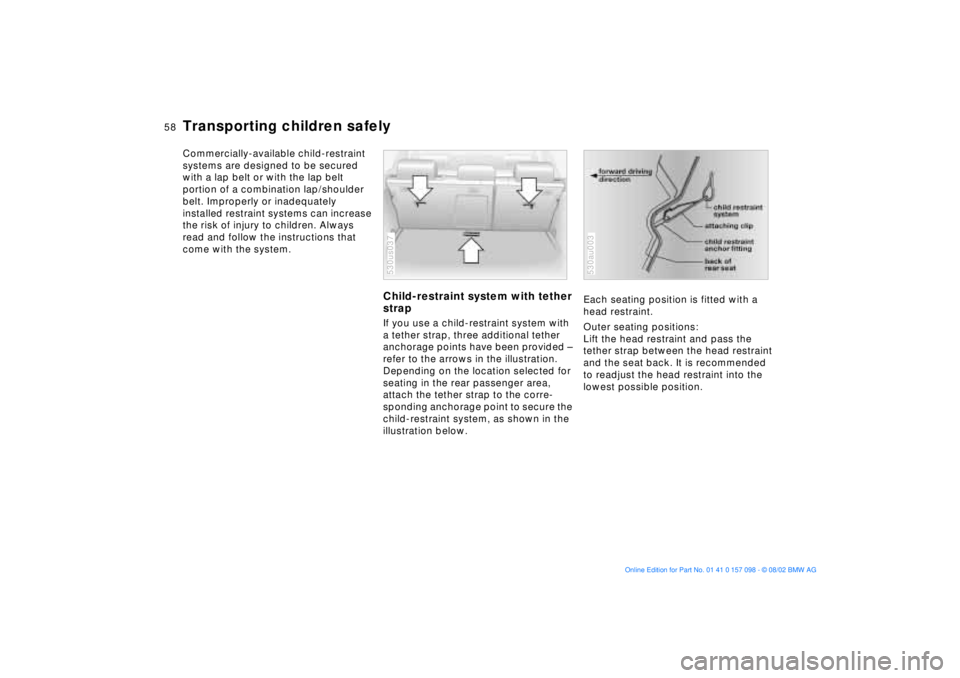
58n
Transporting children safelyCommercially-available child-restraint
systems are designed to be secured
with a lap belt or with the lap belt
portion of a combination lap/shoulder
belt. Improperly or inadequately
installed restraint systems can increase
the risk of injury to children. Always
read and follow the instructions that
come with the system.
Child-restraint system with tether
strap If you use a child-restraint system with
a tether strap, three additional tether
anchorage points have been provided Ð
refer to the arrows in the illustration.
Depending on the location selected for
seating in the rear passenger area,
attach the tether strap to the corre-
sponding anchorage point to secure the
child-restraint system, as shown in the
illustration below. 530us037
Each seating position is fitted with a
head restraint.
Outer seating positions:
Lift the head restraint and pass the
tether strap between the head restraint
and the seat back. It is recommended
to readjust the head restraint into the
lowest possible position. 530au003
Page 59 of 183
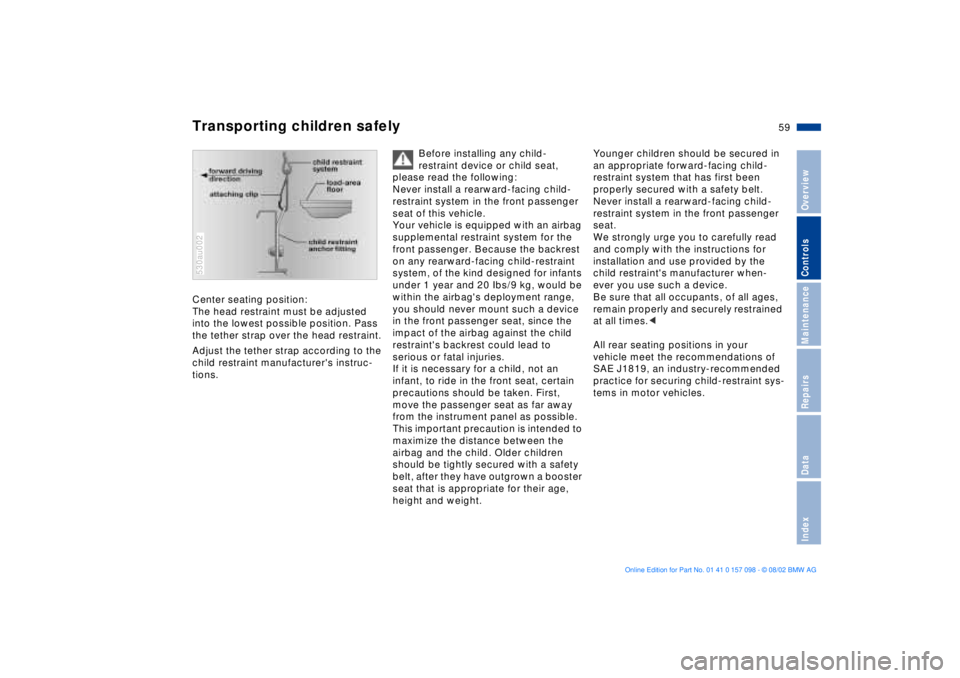
59n
OverviewControlsMaintenanceRepairsDataIndex
Transporting children safely
Center seating position:
The head restraint must be adjusted
into the lowest possible position. Pass
the tether strap over the head restraint.
Adjust the tether strap according to the
child restraint manufacturer's instruc-
tions.530au002
Before installing any child-
restraint device or child seat,
please read the following:
Never install a rearward-facing child-
restraint system in the front passenger
seat of this vehicle.
Your vehicle is equipped with an airbag
supplemental restraint system for the
front passenger. Because the backrest
on any rearward-facing child-restraint
system, of the kind designed for infants
under 1 year and 20 Ibs/9 kg, would be
within the airbag's deployment range,
you should never mount such a device
in the front passenger seat, since the
impact of the airbag against the child
restraint's backrest could lead to
serious or fatal injuries.
If it is necessary for a child, not an
infant, to ride in the front seat, certain
precautions should be taken. First,
move the passenger seat as far away
from the instrument panel as possible.
This important precaution is intended to
maximize the distance between the
airbag and the child. Older children
should be tightly secured with a safety
belt, after they have outgrown a booster
seat that is appropriate for their age,
height and weight.
Younger children should be secured in
an appropriate forward-facing child-
restraint system that has first been
properly secured with a safety belt.
Never install a rearward-facing child-
restraint system in the front passenger
seat.
We strongly urge you to carefully read
and comply with the instructions for
installation and use provided by the
child restraint's manufacturer when-
ever you use such a device.
Be sure that all occupants, of all ages,
remain properly and securely restrained
at all times.<
All rear seating positions in your
vehicle meet the recommendations of
SAE J1819, an industry-recommended
practice for securing child-restraint sys-
tems in motor vehicles.
Page 60 of 183
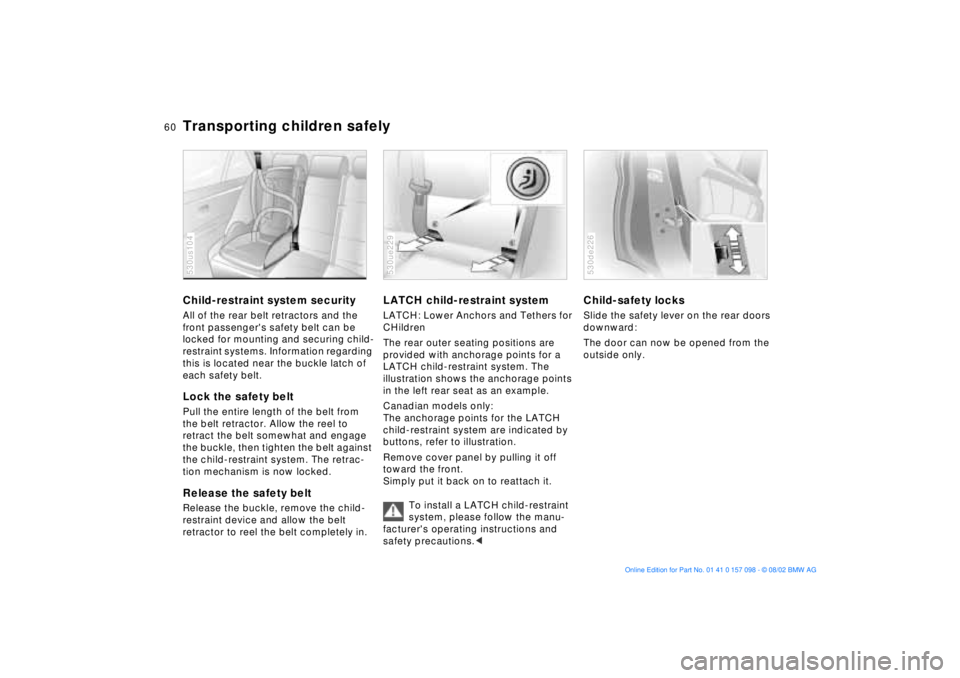
60n
Transporting children safelyChild-restraint system securityAll of the rear belt retractors and the
front passenger's safety belt can be
locked for mounting and securing child-
restraint systems. Information regarding
this is located near the buckle latch of
each safety belt. Lock the safety belt Pull the entire length of the belt from
the belt retractor. Allow the reel to
retract the belt somewhat and engage
the buckle, then tighten the belt against
the child-restraint system. The retrac-
tion mechanism is now locked. Release the safety belt Release the buckle, remove the child-
restraint device and allow the belt
retractor to reel the belt completely in. 530us104
LATCH child-restraint systemLATCH: Lower Anchors and Tethers for
CHildren
The rear outer seating positions are
provided with anchorage points for a
LATCH child-restraint system. The
illustration shows the anchorage points
in the left rear seat as an example.
Canadian models only:
The anchorage points for the LATCH
child-restraint system are indicated by
buttons, refer to illustration.
Remove cover panel by pulling it off
toward the front.
Simply put it back on to reattach it.
To install a LATCH child-restraint
system, please follow the manu-
facturer's operating instructions and
safety precautions.<530ue229
Child-safety locksSlide the safety lever on the rear doors
downward:
The door can now be opened from the
outside only. 530de226
Page 177 of 183
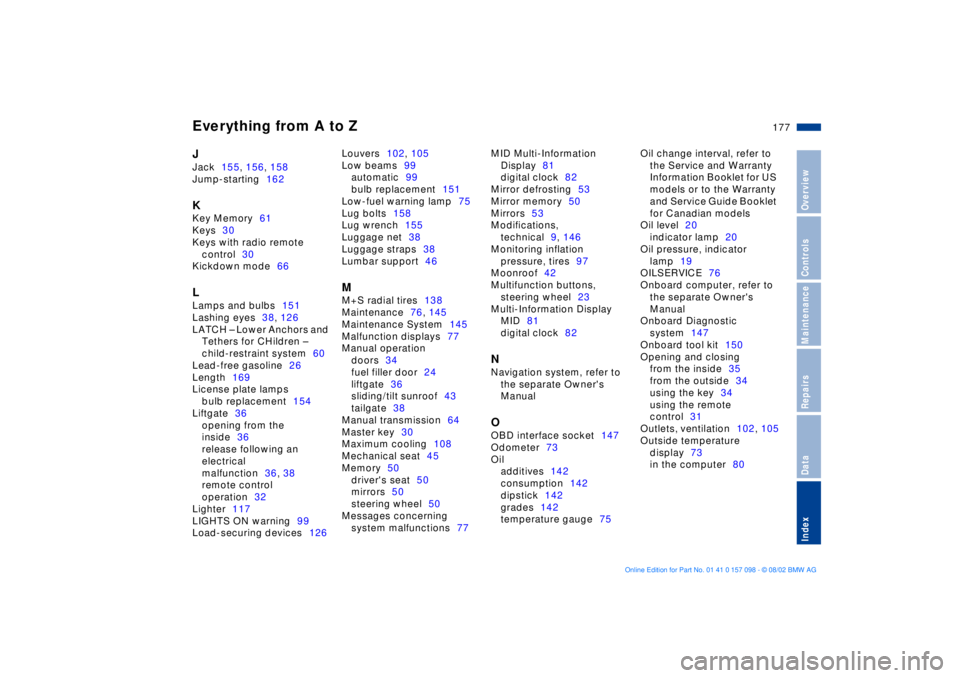
Everything from A to Z
177n
OverviewControlsMaintenanceRepairsDataIndex
JJack155, 156, 158
Jump-starting162KKey Memory61
Keys30
Keys with radio remote
control30
Kickdown mode66LLamps and bulbs151
Lashing eyes38, 126
LATCH Ð Lower Anchors and
Tethers for CHildren Ð
child-restraint system60
Lead-free gasoline26
Length169
License plate lamps
bulb replacement154
Liftgate36
opening from the
inside36
release following an
electrical
malfunction36, 38
remote control
operation32
Lighter117
LIGHTS ON warning99
Load-securing devices126Louvers102, 105
Low beams99
automatic99
bulb replacement151
Low-fuel warning lamp75
Lug bolts158
Lug wrench155
Luggage net38
Luggage straps38
Lumbar support46
MM+S radial tires138
Maintenance76, 145
Maintenance System145
Malfunction displays77
Manual operation
doors34
fuel filler door24
liftgate36
sliding/tilt sunroof43
tailgate38
Manual transmission64
Master key30
Maximum cooling108
Mechanical seat45
Memory50
driver's seat50
mirrors50
steering wheel50
Messages concerning
system malfunctions77MID Multi-Information
Display81
digital clock82
Mirror defrosting53
Mirror memory50
Mirrors53
Modifications,
technical9, 146
Monitoring inflation
pressure, tires97
Moonroof42
Multifunction buttons,
steering wheel23
Multi-Information Display
MID81
digital clock82
NNavigation system, refer to
the separate Owner's
ManualOOBD interface socket147
Odometer73
Oil
additives142
consumption142
dipstick142
grades142
temperature gauge75Oil change interval, refer to
the Service and Warranty
Information Booklet for US
models or to the Warranty
and Service Guide Booklet
for Canadian models
Oil level20
indicator lamp20
Oil pressure, indicator
lamp19
OILSERVICE76
Onboard computer, refer to
the separate Owner's
Manual
Onboard Diagnostic
system147
Onboard tool kit150
Opening and closing
from the inside35
from the outside34
using the key34
using the remote
control31
Outlets, ventilation102, 105
Outside temperature
display73
in the computer80